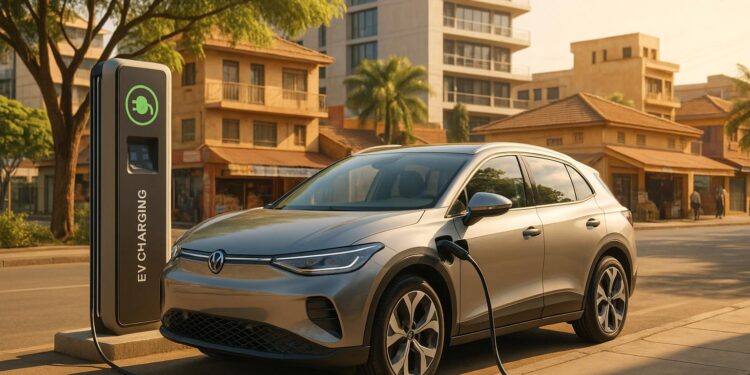Electric vehicles (EVs) in Uganda are becoming more accessible in 2025, with options ranging from locally made cars to imported models and electric bikes. Here’s a quick breakdown:
- Local EVs: Uganda’s Kiira Motors offers the Kiira EVS sedan for around $35,000 and Kayoola EVS buses for public transport.
- New Imported EVs: Prices start at $25,000 for models like the Nissan Leaf and go up to $80,000 for luxury brands such as Tesla and Mercedes.
- Used Imported EVs: A more affordable option, but battery health and warranties can vary.
- Electric Bikes & Scooters: A cost-effective choice for short commutes, with growing local assembly efforts.
While local EVs are supported by government incentives, imported models offer more variety and advanced features. Charging infrastructure is still developing, making smaller vehicles more practical for now.
Uganda’s Electric Vehicles and Prices in Kampala 2025
1. Local EVs
Uganda’s electric vehicle industry is steadily growing, with Kiira Motors Corporation leading the charge as the country’s primary local EV manufacturer.
Price Range
The flagship model, the Kiira EVS, is priced at approximately $35,000. This price reflects the craftsmanship and engineering behind Uganda’s locally developed electric vehicles.
Vehicle Type
Kiira Motors Corporation offers two main types of electric vehicles. The Kiira EVS is designed as a passenger car, while the Kayoola EVS electric buses cater to mass transit and commercial transportation. In November 2024, E-Bus Xpress launched Uganda’s first electric bus mass transit service. The service operates seven Kayoola EVS buses on routes such as Jinja-Iganga, Jinja-Mutai, and Jinja-Mbiko, showcasing the practicality of locally produced EVs for public transportation.
Origin
Reflecting their local roots, these electric buses incorporate 21% local content in their production. The Ugandan government actively supports this burgeoning industry with various incentives, including a ten-year income tax exemption, VAT exemptions for locally manufactured EVs and charging equipment, and reduced import duties on essential production materials.
2. New Imported EVs
Uganda’s market for new imported electric vehicles is growing, with a variety of models showcasing cutting-edge technology. These vehicles, supplied by major international manufacturers, bring the latest features to the table. Compared to locally produced EVs, imported models offer a wider range of pricing and performance options. While local EVs focus on supporting domestic production, imported ones emphasize advanced technology and cater to diverse consumer needs.
Price Range
New imported EVs in Uganda typically range in price from $25,000 to $80,000. For instance:
- The Nissan Leaf starts in the upper $20,000s.
- Mid-range options like the Hyundai Kona Electric and Kia EV6 are priced between $35,000 and $50,000.
- High-end models, such as the Tesla Model S, can cost $75,000 or more.
These prices are influenced by factors such as import duties, VAT, dealer markups, and any available government incentives.
Vehicle Type
Imported EVs come in a variety of types to meet different needs:
- Compact Cars: Models like the Nissan Leaf and Renault Zoe are ideal for city driving.
- Mid-Size SUVs: Choices such as the Hyundai Ioniq 5 and Volkswagen ID.4 offer more space for families.
- Luxury Sedans: Vehicles like the BMW i4 and Mercedes EQS appeal to buyers seeking premium features and exceptional comfort.
- Electric Pickup Trucks: Emerging models, including the Ford F-150 Lightning, are gaining traction among commercial users and outdoor enthusiasts.
This variety reflects the diverse preferences of Ugandan consumers as the EV market continues to expand.
Range (Miles)
The driving range of imported EVs varies by model:
- Entry-Level Models: Offer between 150 and 200 miles per charge. For example:
- The Nissan Leaf provides about 150 miles.
- The Chevrolet Bolt EV delivers approximately 259 miles.
- Premium Models: High-end vehicles like the Tesla Model S can reach up to 405 miles, while the Mercedes EQS exceeds 400 miles.
These range options cater to both short urban commutes and longer road trips.
Origin
Imported EVs in Uganda primarily come from Japan, South Korea, Germany, and the United States:
- Japan: Brands like Nissan dominate in volume sales, thanks to their extensive dealer networks and reputation for reliability.
- South Korea: Companies such as Hyundai and Kia have gained popularity with competitively priced models featuring advanced technology.
- Germany: Luxury brands like BMW, Mercedes-Benz, and Audi continue to attract premium buyers.
- United States: Tesla has built a strong following among tech enthusiasts.
- China: Manufacturers like BYD are starting to make an impact with more affordable EVs, which could influence future pricing trends.
This mix of origins highlights the global nature of Uganda’s EV market, offering options for every budget and preference.
sbb-itb-7bab64a
3. Used Imported EVs
For those in Uganda looking to own an electric vehicle (EV) without breaking the bank, exploring the used EV market could be a smart move. Compared to brand-new models, used imports often come at a more affordable price. However, it’s important to carefully evaluate factors like battery health, warranties, and service history before making a purchase.
Price Range
The cost of used imported EVs depends on factors such as their age, mileage, and overall condition. Some models can deliver substantial savings compared to new ones, but it’s essential to research current market prices in Uganda to make an informed decision.
Vehicle Types
The selection of used EVs includes a mix of compact sedans and larger SUVs, reflecting trends in global EV retirements. This variety means buyers can often find a model that suits their specific needs and preferences.
Range Considerations
One of the key concerns with used EVs is the potential for reduced driving range, especially in older or high-mileage models. Unlike new imports, these vehicles may not perform to their original specifications. To ensure the EV meets your range requirements, it’s crucial to have the battery and related components professionally inspected.
Country of Origin
Most used EVs in Uganda come from established EV markets. However, the origin of the vehicle can influence factors like import procedures and available after-sales support. Buyers should consider these elements carefully, as they can impact the long-term ownership experience. As import practices continue to evolve, they’ll likely play a significant role in shaping Uganda’s used EV market.
4. Electric Bikes and Scooters
Uganda’s growing electric vehicle (EV) market is making room for electric bikes and scooters, which provide a budget-friendly way for eco-conscious commuters to embrace electric transportation. These two-wheeled options are becoming popular as they usually require a smaller initial investment compared to full-sized electric cars.
Price Range
While exact pricing for electric bikes and scooters in Uganda isn’t widely available yet, they are expected to be more affordable than electric cars. Supportive government policies and an increase in local assembly – expected to reach 40% locally produced content for electric motorcycles by 2024 – are helping to maintain competitive prices. This affordability is paving the way for a variety of two-wheeler designs to hit the market.
Vehicle Type
Uganda’s electric two-wheeler market is developing rapidly, offering options for different needs. Entry-level electric scooters are lightweight and ideal for quick urban commutes or short trips. On the other hand, electric motorcycles are designed for those who need more power, whether for longer distances or commercial purposes. These varied designs cater to a broad range of users and performance expectations.
Range
Details about the range of these vehicles are still emerging as manufacturers enhance battery technology. These advancements aim to improve performance, making electric bikes and scooters better suited for everyday commuting.
Origin
Most electric bikes and scooters in Uganda are currently imported, particularly from Chinese manufacturers. However, local assembly is on the rise, driven by Uganda’s ambition to fully electrify motorcycles by 2030. This growing investment combines international designs with local production efforts, signaling a bright future for the industry.
Benefits and Drawbacks
Electric vehicle (EV) options in Uganda come with their own set of perks and challenges, making it essential to weigh your choices carefully based on your budget and needs. Here’s a breakdown of the key points for each category.
Local EVs stand out for their affordability when it comes to maintenance, thanks to locally available parts and service support. However, the choices are limited, and the technology is still in its early stages compared to more established international brands.
New imported EVs bring advanced battery technology, top-notch safety features, and a track record of reliability. The downside? They come with steep upfront costs and potential delays in importation.
Used imported EVs are the most budget-friendly way to get started with EVs. But there’s a catch: battery degradation can reduce range and lead to expensive replacements. Plus, warranties are often limited or entirely absent.
Electric bikes and scooters are ideal for short urban commutes, requiring a small investment and offering easy charging options. On the flip side, their limited passenger and cargo capacity, along with their unsuitability for longer trips or highway use, can be a drawback.
Summary of Benefits and Drawbacks
| Category | Price Range | Main Benefits | Key Drawbacks |
|---|---|---|---|
| Local EVs | Moderate | Affordable maintenance, local support | Limited options, evolving technology |
| New Imported EVs | High | Advanced features, full warranty | High initial cost, import delays |
| Used Imported EVs | Low to Moderate | Budget-friendly, proven reliability | Battery issues, limited or no warranty |
| Electric Bikes/Scooters | Low | Low cost, easy to charge | Short range, small passenger capacity |
Another important factor to consider is Uganda’s charging and maintenance infrastructure. The country’s charging network is still in its early stages, which impacts the practicality of owning larger EVs. While electric bikes and scooters can easily charge using standard wall outlets, full-sized EVs often require dedicated charging stations, which are currently scarce.
Maintenance is another area where differences emerge. Local EVs are easier to maintain due to the availability of parts and service within the country. In contrast, imported models may face delays in servicing because specialized parts are harder to find. Electric bikes and scooters, with their simpler designs, are generally easier and cheaper to repair.
These challenges reflect the growing pains of Uganda’s EV market as the country works toward expanding electric vehicle adoption by 2025.
FAQs
What incentives does the Ugandan government provide to make electric vehicles more affordable?
The Ugandan government has rolled out various incentives to promote the use of electric vehicles (EVs). Among these are exemptions from the 18% Value Added Tax (VAT), stamp duty, and income tax on EV purchases. For local EV manufacturers, there’s an added benefit: a 25% duty exemption, provided they meet certain conditions, like employing at least 80% Ugandan workers and sourcing 80% of their raw materials locally.
These initiatives are designed to make EVs more affordable for consumers while also encouraging local production and supporting broader efforts to improve sustainability.
How does charging infrastructure affect the practicality of owning an electric vehicle in Uganda?
Charging infrastructure is key to making electric vehicle (EV) ownership practical in Uganda. Without a dependable and extensive network of charging stations, EV owners could struggle with long-distance travel and even day-to-day use.
Uganda has set ambitious goals to electrify public transportation by 2030 and private vehicles by 2040. However, the absence of standardized charging stations is a major hurdle. Expanding the infrastructure and adopting universal charging standards will be critical to improving convenience and accessibility for EV users across the country.
What should I consider when buying a used imported electric vehicle in Uganda?
When buying a used imported electric vehicle (EV) in Uganda, there are a few important things to consider:
- Vehicle age: Uganda limits imported vehicles to a maximum of 15 years old. However, bringing in an EV older than 9 years could mean higher fees, while models 8 years old or newer are usually more affordable to import.
- Emission standards: The vehicle must comply with Euro 4 emission standards, which typically applies to EVs manufactured from 2016 onward.
- Insurance: Every imported EV must be insured through a licensed provider in Uganda.
These factors can help you evaluate both the practicality and costs of owning an imported EV in Uganda.
Related Blog Posts
- Top 5 Electric Vehicles Gaining Popularity in Uganda
- Electric Cars in Uganda: What’s Available and Where to Buy ⚡️
- Electric Cars in Uganda: 2025 Guide for New Buyers
- How Much Do Cars Cost in Uganda in 2025? Full Guide




